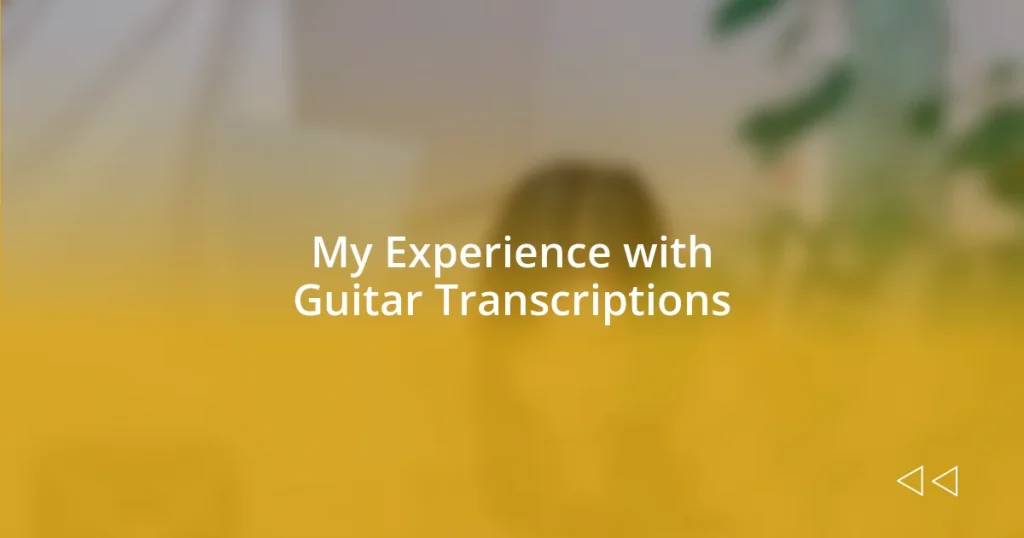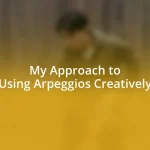Key takeaways:
- Transcribing music deepens the understanding of nuances, emotional expression, and the artist’s intent beyond just note accuracy.
- The use of specialized tools like transcription software, notation programs, and chord finder apps significantly enhances the efficiency and accuracy of the transcription process.
- Engaging with resources such as online platforms, tutorials, and community discussions fosters skill development, creativity, and emotional connection to music.

Understanding Guitar Transcriptions
Guitar transcriptions are a fascinating way to decode the music played on the guitar into written format. I vividly remember the first time I tackled a transcription of a challenging piece; the rush of figuring out each note was thrilling. Have you ever felt that rush when finally nailing a tricky solo? It’s a blend of frustration and triumph that truly deepens your connection to the music.
When I started transcribing songs, I learned quickly that it’s not just about writing down notes; it’s about interpreting the nuances of the piece and understanding the original artist’s intent. For example, while working through a jazz standard, I discovered subtle slides and bends that made the performance come alive. These details often reveal deeper layers of emotion in the music, transforming the transcription process into a journey of musical discovery.
Transcriptions can also serve as a powerful tool for learning. You might ask yourself, how can deciphering one song improve your skills in general? I found that analyzing how certain riffs are constructed can reveal common patterns applicable across various genres. This approach not only boosts technical skills but also enhances creativity, allowing you to explore your own musical ideas more freely.

Tools for Guitar Transcription
When it comes to guitar transcription, the right tools can make all the difference in your efficiency and accuracy. I remember my first experiences using transcription software and how those digital aids turned what once felt like a daunting task into something much more manageable. Programs like Transcribe! and Guitar Pro allowed me to slow down recordings, isolate sections, and loop difficult parts, which significantly improved my learning curve.
Here’s a breakdown of some essential tools I recommend for guitar transcriptions:
- Transcription Software: Tools like Transcribe! and Amazing Slow Downer help adjust tempo and pitch for easier learning.
- Notation Software: Guitar Pro and Sibelius offer sheet music creation, allowing you to notate your transcriptions effectively.
- Chord Finder Apps: Apps like Ultimate Guitar and Chordify can help identify chords quickly, making it easier to get a grasp on songs.
- Recording Devices: A simple smartphone voice recorder works wonders for capturing melodies or riffs on the fly.
Using these tools not only streamlines the transcription process but elevates the entire musical experience, transforming learning into an enjoyable adventure.

Step by Step Transcription Process
When I embark on a transcription journey, I usually start by selecting a song that excites me. I play the track on repeat, actively listening to each note and nuance. This phase can be a bit overwhelming, especially if the piece contains complex rhythms or intricate solos. I recall feeling both anxious and eager as I navigated through a favorite solo. It’s crucial to find a balance between enjoyment and focus during this initial listening phase, as it sets the foundation for the transcription process.
Next, I break the song down into manageable sections. I often focus on just a few bars at a time, which allows me to dig deeply into the details. I remember a time when I dedicated an entire afternoon to transcribing just a 10-second segment—it may seem excessive, but I was determined to capture every little slide and hammer-on. This meticulous approach not only enriches my understanding of the sculpture of each phrase but also leads to those exhilarating “aha!” moments when things finally click.
Finally, once I have the notes captured, I revisit the transcription to ensure accuracy and interpretative flair. This phase allows my creativity to flourish, as I often annotate my transcriptions with personal insights or embellishments that reflect how I connect with the piece. It’s like assembling a puzzle; sometimes, pieces don’t fit right away, but through patience and practice, the picture becomes clearer. Have you experienced that sense of fulfillment when your hard work results in a playable piece that captures the essence of the original? It’s ultimately what keeps me honing my skills and exploring new musical horizons.
| Step | Description |
|---|---|
| Listen | Play the song repeatedly, focusing on nuances and emotions. |
| Break it Down | Segment the piece into manageable sections for intensive transcription. |
| Revise | Ensure accuracy and add personal interpretations to reflect your connection. |

Tips for Accurate Transcription
Focusing on your listening environment can greatly enhance your transcription accuracy. I usually find a quiet space where distractions are at a minimum, allowing me to connect fully with the music. Have you ever noticed how background noise can mask subtle nuances? When I first started transcribing, I learned that turning off my phone notifications and dimming the lights made a world of difference in my concentration.
One of the most effective tips I’ve picked up is to transcribe using both your ears and eyes. While I might initially listen to the piece to catch the essence, I often bring in a visual element later. For instance, following along with a video can reveal finger placements or hand movements that may not be evident in the audio alone. I still remember the surprise I felt when I realized how watching a guitarist’s subtle finger shifts helped me nail those tricky chord transitions.
Finally, patience plays a crucial role in achieving accurate transcriptions. I recall being frustrated after hours of work on a particularly challenging solo. It was easy to rush through it, but I found that taking breaks boosted my clarity and focus. Sometimes, stepping away for a moment can lead to those breakthrough moments when you return refreshed. Have you experienced similar insights when you give yourself that extra time? It’s often during those pauses that the music truly starts to reveal itself.

Common Challenges in Transcribing
Transcribing music can present a range of challenges, particularly when it comes to interpreting complex rhythms. I remember grappling with a piece that was filled with syncopated beats—every time I thought I had it down, I’d realize I missed a critical note. This struggle often leads to second-guessing my own ears, and I’d find myself replaying sections repeatedly, frustration bubbling up. Have you felt that push and pull between your inner critic and your passion for the music?
Another challenge I’ve faced involves the tonal subtleties that define a piece. Capturing the essence of a guitarist’s unique tone or feel can feel like trying to grasp smoke with your bare hands. I found myself spending hours trying to match the exact sound of a note, only to realize that sometimes it’s less about the technical precision and more about the emotional impact. Those moments of self-doubt can be tough, but they also remind me of the beauty inherent in artistic interpretation.
Lastly, there can be a daunting emotional aspect tied to the pressure of perfection. I vividly recall the anxiety I felt when transcribing a tribute to a beloved artist. The weight of capturing their spirit loomed large, and each note felt like a reflection of their legacy. Have you ever felt the stakes were too high when you worked on something so meaningful? In times like these, it’s essential to remind ourselves that transcribing is also about self-expression, not just accuracy. Embracing imperfections can lead to beautiful personal insights in our musical journeys.

Enhancing Skills with Transcriptions
Transcribing music has a profound impact on my guitar skills. I still remember the first time I sat down for hours, meticulously analyzing a challenging solo by my favorite artist. That immersion not only sharpened my ear but also honed my finger dexterity. Have you ever found that just a few notes, when transcribed and practiced, can unlock a whole new level of playing? For me, those breakthroughs have often been exhilarating.
As I transcribed more pieces, I noticed that my understanding of music theory deepened. I began to recognize patterns and chord progressions that I hadn’t grasped before. This newfound knowledge helped me in my songwriting, and I could create more complex compositions. It’s fascinating how transferring notes from one format to another can lead to such rich revelations. Have you experienced your creativity expanding as you delve deeper into transcriptions?
Another transformative element is the emotional connection I’ve built with the music. When I transcribe a piece with heartfelt expression, it’s as if I’m conversing with the artist. I know this sounds a bit poetic, but there’s an almost therapeutic aspect to capturing their emotional delivery. Have you ever felt a piece resonate with your feelings? Those transcriptions teach me to express my own emotions through the guitar, creating a beautiful loop of inspiration and expression.

Resources for Guitarists and Transcriptions
Exploring resources for guitarists and transcriptions has been a game-changer for me. I discovered that platforms like Ultimate Guitar and MuseScore not only offer extensive libraries of tabs, but also provide a community of musicians to share insights with. Have you ever found a hidden gem in a simple online forum? I remember coming across an insightful discussion on rhythmic patterns that completely changed my approach to transcribing.
YouTube has also been invaluable in my transcription journey. Watching tutorials by seasoned guitarists demystifies complex solos and techniques. Sometimes, seeing someone play a passage in real-time gives me clarity that sheet music just can’t capture. I still chuckle at the time I spent trying to understand a challenging riff, only to have it clicked for me in a matter of minutes through a video. Isn’t it fascinating how a single visual can illuminate the path forward?
And let’s not forget about transcription software! Tools like Transcribe! and AnthemScore have been lifesavers, especially when I’m struggling with a tricky section. I can slow down the music, loop specific parts, and really dissect the notes. The first time I used Transcribe!, I felt like I had found a secret weapon. Have you had an experience where technology transformed your practice? Embracing these resources has allowed me to tackle transcriptions with more confidence and creativity.















